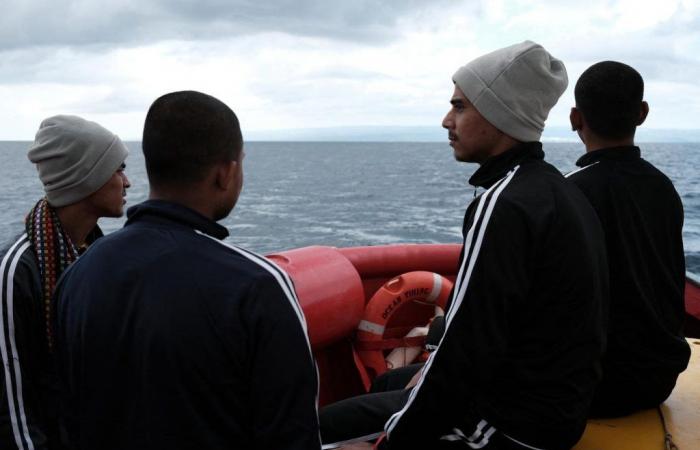There are 16 irregular migrants whose fate is particularly scrutinized: ten men from Bangladesh and six from Egypt. In a spectacular move, the Italian authorities undertook to transport them aboard a patrol boat from the island of Lampedusa to detention centers located in Albania. Their arrival is scheduled for Wednesday, October 16, marking the start of this new program, which consists of transferring irregular migrants to two closed centers in Shëngjin and Gjadër, so that their asylum application can be examined there.
Italy began creating these centers in November 2023. To do this, it had to conclude an agreement with the Albanian authorities: under international conventions, a country does not have the right to return asylum seekers. to another State before their application has been examined. To avoid defaulting, Italy therefore obtained the territory of these detention centers to have the status of an Italian enclave. For the moment, this deportation only concerns men traveling alone, not families. It aims to facilitate their return to their country of departure, if their asylum application is rejected, and to send a message to would-be migrants.
“Return hubs” in the works
When the far-right Italian government launched this initiative a year ago, many European states held their noses. But today, more and more people want to imitate Rome. Thursday October 10, during a meeting of the 27 interior ministers in Luxembourg, Hungary and Italy put on the table a proposal aimed at creating “return hubs” on a European scale. This administrative name designates detention centers in third countries based on the Italian model. French Minister Bruno Retailleau, who is also preparing a new law in France on immigration, judged that this proposal was “a path that should not be dismissed”.
This discussion comes at a time when, for months, European governments have been moving forward in disjointed ways on the subject. Germany has just restored controls at its borders and Poland has mentioned “temporary suspension of the right to asylum” for irregular migrants. For its part, the European Union definitively adopted a Pact on Asylum and Migration in May, which will strengthen controls at the EU’s external borders. This set of texts is due to come into force in the summer of 2026, but, even before its implementation, many European countries are calling for tougher measures. Fifteen states, including Finland, Greece, Austria and the Baltic countries, sent a letter to the European Commission at the end of May asking it to explore “new solutions”. All the signatories are far from being led by the extreme right: among them is, for example, Denmark, with a social-democratic government…
Multiply agreements with third countries
Another proposal was also discussed at the meeting of interior ministers in Luxembourg: the idea of revising the 2008 “return directive”. France and Germany supported a note from the Netherlands and the Austria in this sense. It is about ” facilitate “ and“accelerate” returns of rejected asylum seekers. In response, the President of the European Commission, Ursula von der Leyen, confirmed on Monday October 14 that she would “present a new legislative proposal” with the desire to “effectively streamline the returns process”. The discussion is expected to begin at the European Council on October 17. Brussels is proposing to facilitate expulsions through mutual recognition of decisions taken by each member state.
The Commission is also preparing to systematize agreements with third countries to ask them to block the departures of migrants. The EU has already signed agreements to this effect with Turkey, Tunisia, Mauritania and Egypt and it plans to increase them. It offers these countries commercial advantages and subsidies, it equips their police, pays for surveillance boats, and finances the construction of detention centers. And is less and less careful about the methods used by these countries.
The European Court of Auditors notes this in a report published on September 25. The text focuses on the Emergency Trust Fund for Africa, an envelope of 5 billion euros set up by the Commission, between 2015 and 2023, to “address the root causes of migration”. Part of this money was used to pay “a surveillance system covering the entire Tunisian coastline”. Some EU Member States then requested that non-governmental organizations have access to detained migrants and that victims of abuse have the opportunity to lodge complaints. But all these recommendations were deleted from the final document sent to the Tunisian authorities, the Court of Auditors is surprised in its report.
In Tunisia and Turkey, migrants put in danger
This European money was also used to finance the recruitment of coast guards in Libya. Their Italian counterparts were responsible for training and empowering these officials by making them aware of the “principles and guidelines recommended by the Office of the United Nations High Commissioner for Human Rights”. None of this was done. The European Court of Auditors judges in its report that “risks to human rights have not been adequately addressed” in the use of these 5 billion euros.
More recently, a survey carried out by eight European newspapers, and published in France in The Worldshows that European funds granted to Turkey were used to finance detention centers in which migrants were subjected to pressure. The latter were encouraged to sign a declaration in which they said they “volunteers” for a return. The European Union is also said to have financed buses then used to send hundreds of migrants back to Syria, a country which can hardly be considered ” on “.
As recently as mid-October, independent UN experts denounced the endangerment of migrants in Tunisia. They speak of forced transfers to the borders with Algeria and Libya. “Migrants, refugees and asylum seekers, including children and pregnant women, would be taken to desert areas on the border with Algeria and Libya, and border guards would shoot them if they were trying to come back »they report. The EU thus gives the impression of delegating to others what it does not authorize itself to do in order to close the door to irregular arrivals.
—
Arrivals of illegal immigrants on the decline
In 2023, around 355,300 people entered the European Union (EU) irregularly, highest figure since 2016, according to the European Border Guard Agency (Frontex).
Over the first nine months of 2024, the number of illegal crossings fell by 42%.
The drop is greatest on the Western Balkans route (–79%) and on that of the central Mediterranean (– 64%), while crossings at the eastern border of the EU are increasing (+ 192%).
The main countries of origin of irregular migrants at European borders are Syria, Mali and Ukraine.
Germany recorded the highest number of asylum applications (334,000) in 2023, or around 30% of the total. Followed by France (167,000 applications), Spain (162,000) and Italy (136,000), according to the European Union Agency for Asylum.
France’s rate of execution of removal measures is the lowest in the EU: around 7%. The European average is close to 20%.






